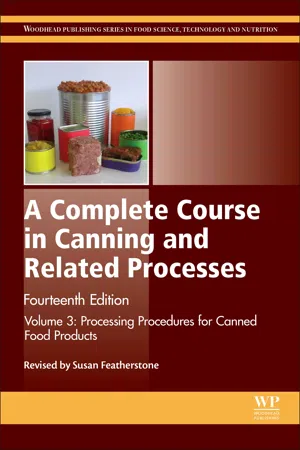
A Complete Course in Canning and Related Processes
Volume 3 Processing Procedures for Canned Food Products
- 534 pages
- English
- ePUB (mobile friendly)
- Available on iOS & Android
A Complete Course in Canning and Related Processes
Volume 3 Processing Procedures for Canned Food Products
About This Book
A Complete Course in Canning and Related Processes: Volume 3, Processing Procedures for Canned Food Products, Fourteenth Edition provides a complete course in canning and is an essential guide to canning and related processes.
Professionals and students in the canning industry have benefited from successive editions of the book for over 100 years. This major new edition continues that reputation, with extensively revised and expanded coverage.
The book's three-title set is designed to cover all planning, processing, storage, and quality control phases undertaken by the canning industry in a detailed, yet accessible fashion.
Major changes for the new edition include new chapters on regulation and labeling that contrast the situation in different regions worldwide, updated information on containers for canned foods, and new information on validation and optimization of canning processes, among many other topics.
- Extensively revised and expanded coverage in the field of food canning
- Designed to cover all planning, processing, storage, and quality control phases undertaken by the canning industry in a detailed, yet accessible fashion
- Examines the canning of various fruits and vegetables, in addition to meat, milk, fish, and composite products
- Updated to cover the canning of ready meals, pet food, and UHT milk
Frequently asked questions
Information
Canning of vegetables
Abstract
Acknowledgments
1.1 Introduction
| Vegetable | pH | Vegetable | pH | Vegetable | pH |
| Artichokes | 5.50 –6.00 | Eggplant | 5.50–6.50 | Peas | 5.70–6.80 |
| Asparagus | 6.00–6.70 | Garlic | 5.80 | Peppers, green | 5.20–5.95 |
| Bamboo shoots | 5.10–6.20 | Horseradish | 5.35 | Potatoes | 5.40–5.90 |
| Beans | 5.60–6.50 | Mushrooms | 6.00–6.70 | Pumpkin | 4.90–5.50 |
| Beets | 5.30–6.60 | Okra | 5.50–6.60 | Spinach | 5.50–6.80 |
| Cabbage | 5.20–6.80 | Olives | 6.00–7.50 | Squash | 5.20–6.50 |
| Carrots | 5.90–6.40 | Onion white | 5.30–5.85 | Turnips | 5.30–5.90 |
| Corn | 5.90–7.30 | Palm, heart of | 5.70–6.70 | Water chestnut | 6.00–6.20 |
| Can size | Maximum fill weight | Minimum initial temperature | Minutes at retort temperature | ||||
| Oz. | g | °F | °C | 116 °C (240 °F) | 118 °C (245 °F) | 121 °C (250 °F) | |
| 211 × 304 | 5.3 | 150 | 70 | 21 | 22 | 17 | 13 |
| 120 | 49 | 21 | 15 | 12 | |||
| 211 × 304 | 6.5 | 184 | 70 | 21 | 24 | 19 | 16 |
| 120 | 49 | 23 | 18 | 15 | |||
| 211 × 400 | 6.8 | 193 | 70 | 21 | 20 | 15 | 12 |
| 120 | 49 | 19 | 14 | 12 | |||
| 211 × 400 | 8.5 | 241 | 70 | 21 | 23 | 18 | 15 |
| 120 | 49 | 22 | 17 | 14 | |||
| 300 × 407 | 9.7 | 275 | 70 | 21 | 26 | 19 | 15 |
| 300 × 409 | 10 | 284 | 120 | 49 | 23 | 17 | 13 |
| 300 × 407 | 10.7 | 303 | 70 | 21 | 30 | 24 | 19 |
| 300 × 409 | 11 | 312 | 120 | 49 | 27 | 21 | 17 |
| 603 × 700 | 68 | 1928 | 70 | 21 | 43 | 32 | 25 |
| 120 | 49 | 36 | 27 | 20 | |||
| Can size | Maximum fill weight | Minimum initial temperature | Minutes at retort temperature | ||||
| Oz. | g | °F | °C | 116 °C (240 °F) | 118 °C (245 °F) | 121 °C (250 °F) | |
| 211 × 304 | 6.5 | 184 | 70 | 21 | 27 | 22 | 19 |
| 211 × 400 | 8.2 | 233 | 120 | 49 | 25 | 20 | 17 |
| 211 × 510 | 11.9 | 337 | |||||
| 300 × 407 | 11.5 | 326 | |||||
| 307 × 409 | 15.5 | 439 | |||||
| 603 × 408 | 45.5 | 1290 | 70 120 | 21 49 | 32 29 | 25 23 | 21 19 |
| Can size | Maximum fill weight | Minimum initial temperature | Minutes at retort temperature | ||||
| Oz. | g | °F | °C | 116 °C (240 °F) | 118 °C (245 °F) | 121 °C (250 °F) | |
| 211 × 304 | 6.7 | 190 | 70 | 21 | 30 | 25 | 21 |
| 211 × 400 | 8.4 | 238 | 120 | 49 | 28 | 23 | 20 |
| 211 × 510 | 12.2 | 346 | |||||
| 300 × 407 | 11.8 | 335 | |||||
| 307 × 409 | 15.9... | ||||||
Table of contents
- Cover image
- Title page
- Table of Contents
- Copyright
- Woodhead Publishing Series in Food Science, Technology and Nutrition
- Preface
- Introduction
- Part One: Fruits, Vegetables, and Pulses
- Part Two: Meat, Fish, and Milk
- Part Three: Canning of Preserves and Pickles
- Part Four: Canning of Composite Products
- Appendix
- Glossary
- Index


